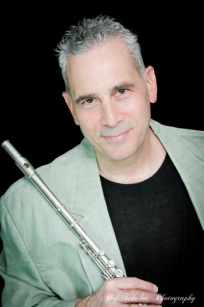Audio clip: Adobe Flash Player (version 9 or above) is required to play this audio clip. Download the latest version here. You also need to have JavaScript enabled in your browser.
Download the PDF: Concert
This post was very generously provided by Marc Adler, a fantastic flutist and pedagogue out of PA. The above track is off the album Autumn Smiles played by Marc Adler, flute; Jim Ridl, piano; Darryl Hall, bass; Butch Reed, drums; and John Swana, trumpet. Marc sent along a “brief” analysis of the tune (below) which may not look brief on first glance, but compared to the subtlety of the recording it’s just the tip of the iceberg. And since we’re already getting the inside scoop on the music theory behind this tune–the skeleton of the music–I took the opportunity to ask Marc about the soft/squishy side of the music. Here’s what he had to say about the context of the album, and this tune in particular:
The tune was written to celebrate all of the beautiful things that have occurred for one reason or another in the Autumn: meeting my lovely wife, Marlene, getting married, our birthdays. It’s a beautiful time of the year…hence, Autumn Smiles. The album was made possible through a jazz fellowship from the Pennsylvania Council on the Arts. The musicians were a pleasure to work with and we covered a fair amount of musical ground. Also on the album are tunes dedicated to various significant people in my life – a tune dedicated to my daughter, Simone (Simone); a tune dedicated to the time I lived with my grandparents (Mother’s Parents) on “F” Street in Philadelphia (F Street), and a tune dedicated to the late, great Joe Farrell (Ode to Joe Farrell). I am inspired by many varied forms and styles of music, composers and performers. Sincerity is the main factor – you can hear it in the music.
Marc’s analysis is as follows:
Autumn Smiles Flute Solo Brief Analysis
This is a fully transcribed solo as performed by Marc Adler on his composition Autumn Smiles as featured on his CD Flute Improvisations. Altered chords and chromaticism are used throughout the solo so that the chord changes and notes below do not always, at least at first, appear to match.
Formal and Harmonic Structure
The form is basically A B A with a long developmental B section. The tonal center is Bb major for the A sections with the B section modulating to the following tonal centers: Db major (13 – 14), G minor (18 – 19) and Ab major (22 – 25) before returning to Bb major (28). The solo consists of two complete choruses of the tune (70 measures).
The harmonic structure of the tune is as follows:
- A section: Bb: I | V7/vi | IV #IV | bVI bVII7 | repeat previous 4 measures ||
- B section: Bb: I | V7/vi | vi | Db: bVII7 | bVII7 | I | bVII | g: ii (TT) | V7 | i | i | Ab: ii (TT) | V7 (TT) | I (PC) | I | I | I | Bb: ii (TT) | V7 ||
- A section: Bb: I | V7/vi | vi | V7/V | V7 | V7 | V7 | V7 ||
Abbreviations Key
- TT = Tritone Substitution: interchangeable chords a tritone apart (six semitones i.e.: e minor for Bb minor, etc.)
- PC = Polychords: triads superimposed over a pedal point i.e.: E/Ab, Bb/Ab, etc.
Melodic Structure
Scales used in solo:
- Diminished–Measures: 4 (Ab 13); 12-13 (B7#9); 20-21 (Emin7b5 – A7b9); 34 (D/F); 41 (D7#9); 45 (D7#9); 47-48 (B7#9); 52 (D/F#); 53-54 (Gmin); 55-56 (Emin7b5 – A7b9); 61-62 (Gb13 – F7#5); 69 (D/F).
- Pentatonic–Measures: 1 (Bbmaj2); 14 (Dbmaj7#11); 14 (Bmaj7#11); 50 (Bmaj7#11).
- Jazz Patterns–Measures: 1 (Bbmaj2); 19 (Gmin/F); 31 (C7); 34 (D/F); 56 (A7b9); 60 (Ebmaj7#11/Ab); 71 (Bbmaj2).
- Triads and Sevenths Chords used melodically–Measure: 32-33 (Eb/F) C minor 7th chord; 44 (Bbmaj2) C major triad; 45 (D7#9) F major triad.
Melodic Contour of solo: each descending statement is usually followed by an opposing ascending statement. For examples see measures 19 -20 and 22-24. Also 24-27 followed by 28-29, 47-49 followed by 50-53, and finally 66-68 followed by 68-70.
